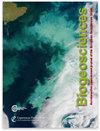From Iron Curtain to green belt: shift from heterotrophic to autotrophic nitrogen retention in the Elbe River over 35 years of passive restoration
IF 3.9
2区 地球科学
Q1 ECOLOGY
引用次数: 0
Abstract
Abstract. We investigate changes to in-stream nitrogen retention and metabolic processes in the Elbe River between 1978 and 2020. We analyzed multidecadal time series data and developed a metabolic nitrogen demand model to explain trends in dissolved inorganic nitrogen (DIN) retention, gross primary production (GPP), and ecosystem respiration (ER) during a period of highly dynamic pollution pressures in the Elbe River (central Europe). Our findings reveal a marked increase in summer DIN retention and a decrease in winter DIN retention, establishing a distinct seasonal pattern. We identified three distinct periods in the Elbe's DIN retention dynamics: dominantly heterotrophic under high organic and inorganic pollution pressure (1980–1990), transition (1990–2003), and dominantly autotrophic with lower pollution (2003–2017). We link these changes to reduced industrial pollution, improved wastewater treatment, and a shift in the in-stream balance between heterotrophic and autotrophic processes. During the first period, high ER caused elevated metabolic nitrogen demands, primarily driven by heterotrophic processes. As pollution from industrial and wastewater emissions decreased, GPP rates increased and ER gradually declined, prompting a shift towards an autotrophic-dominated nitrogen retention regime. Our study indicates tight coupling of nutrient reduction from external sources and dominant processes of natural attenuation in large rivers, which needs to be considered for projections of recovery trajectories for sustainable water quality.从铁幕到绿化带:易北河被动恢复 35 年来从异养氮截留到自养氮截留的转变
摘要我们研究了易北河在 1978 年至 2020 年间的内流氮滞留和代谢过程的变化。我们分析了十年以上的时间序列数据,并建立了一个氮需求代谢模型,以解释易北河(欧洲中部)在污染压力高度动态变化期间溶解无机氮(DIN)滞留、总初级生产力(GPP)和生态系统呼吸(ER)的变化趋势。我们的研究结果表明,夏季的 DIN 停留量明显增加,而冬季的 DIN 停留量则有所减少,从而形成了一个明显的季节性模式。我们确定了易北河 DIN 滞留动态的三个不同时期:高有机和无机污染压力下的主要异养型时期(1980-1990 年)、过渡时期(1990-2003 年)和污染较低的主要自养型时期(2003-2017 年)。我们将这些变化与工业污染减少、废水处理改善以及异养和自养过程之间的内流平衡转变联系起来。在第一阶段,高ER导致代谢氮需求增加,主要由异养过程驱动。随着工业和废水排放污染的减少,GPP速率增加,ER逐渐下降,促使氮滞留机制向自养为主的方向转变。我们的研究表明,外部来源的营养物质减少与大江大河中自然衰减的主导过程紧密耦合,在预测可持续水质的恢复轨迹时需要考虑到这一点。
本文章由计算机程序翻译,如有差异,请以英文原文为准。
求助全文
约1分钟内获得全文
求助全文
来源期刊

Biogeosciences
环境科学-地球科学综合
CiteScore
8.60
自引率
8.20%
发文量
258
审稿时长
4.2 months
期刊介绍:
Biogeosciences (BG) is an international scientific journal dedicated to the publication and discussion of research articles, short communications and review papers on all aspects of the interactions between the biological, chemical and physical processes in terrestrial or extraterrestrial life with the geosphere, hydrosphere and atmosphere. The objective of the journal is to cut across the boundaries of established sciences and achieve an interdisciplinary view of these interactions. Experimental, conceptual and modelling approaches are welcome.
文献相关原料
| 公司名称 | 产品信息 | 采购帮参考价格 |
|---|
 求助内容:
求助内容: 应助结果提醒方式:
应助结果提醒方式:


